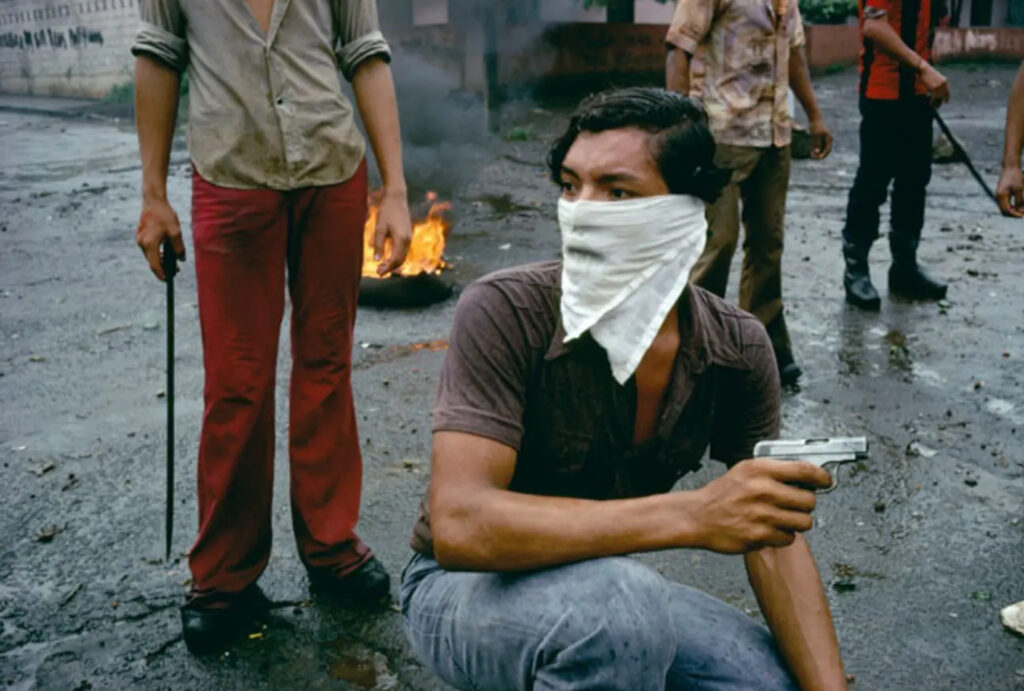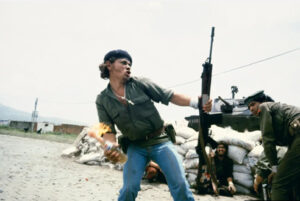The weight of history often settles most heavily in the quiet moments between frames. When Susan Meiselas returned to her contact sheets decades after documenting Nicaragua’s insurrection against the Somoza dictatorship, she wasn’t just revisiting frozen instants of rebellion and resilience. She was re-encountering a nation’s birth pangs, a visual language she helped define, and the enduring legacy of U.S. intervention that shaped the very revolution she chronicled. The new edition of her seminal photobook, Nicaragua: June 1978–July 1979, isn’t just a reprint—it’s an invitation to re-examine power, resistance, and representation that bind Nicaragua’s past to its turbulent present.
To grasp the Sandinista revolution’s significance, one must contend with the deep-rooted history of foreign domination in Nicaragua. The U.S.’s 19th-century doctrine of Manifest Destiny soon turned southward. In 1890, American minister to Nicaragua, William L. Merry, declared: “The construction of the Nicaraguan canal will secure the domination of the United States over the American continent.” While Panama ultimately hosted the canal, the political script had been written—Nicaragua’s sovereignty would long be subordinated to American strategic interests.
That pattern solidified in 1936 with the rise of the Somoza dynasty. Anastasio Somoza García, backed by U.S. support, and later his sons Luis and Anastasio Somoza Debayle, ruled Nicaragua with violent impunity for over four decades. Their rule epitomized kleptocracy: state violence against dissent, land theft, bribery, and the embezzlement of public wealth. The regime’s longevity depended on unwavering support from Washington, which prioritized anti-communism over democracy. The U.S.-trained Nicaraguan National Guard served as the regime’s repressive apparatus.
Opposition grew with time. The Sandinista National Liberation Front (FSLN), named after national hero Augusto César Sandino—who resisted U.S. Marines in the 1920s—emerged as the primary force of resistance. But it was the devastating 1972 earthquake in Managua that exposed the Somozas’ corruption: international aid meant for victims was siphoned by the ruling elite. The FSLN, advocating for land reform and social justice, gained momentum among Nicaragua’s dispossessed. With escalating guerrilla warfare and Mao’s dictum—“Political power grows out of the barrel of a gun”—the FSLN positioned itself for revolution.
A critical turning point arrived with the assassination of Pedro Joaquín Chamorro Cardenal, editor of the opposition newspaper La Prensa. A tireless critic of Somoza, Chamorro understood the fatal cost of press freedom under tyranny. On January 10, 1978, he was murdered by unknown gunmen—widely believed to be Somoza’s agents. His killing sparked nationwide outrage, mass strikes, and open rebellion. It also made headlines internationally, including a full-page in The New York Times. The FSLN gained legitimacy and popular support, transforming localized resistance into full-scale insurrection.
This is where Susan Meiselas enters the frame. A newly minted member of Magnum Photos, she traveled to Nicaragua in June 1978—unassigned, uncertain, but compelled. Armed with two cameras—one loaded with black-and-white film, the other with color—she immersed herself in the heart of a conflict that was far from tidy. What was intended as a brief trip became a year-long stay that changed the trajectory of her life and career.
Meiselas embedded with Sandinista guerrillas, documenting their treks through jungles, tense safe-house meetings, and urban battles. In cities like León and Estelí, she captured scenes of youths hurling Molotov cocktails at tanks, families mourning the dead, and towns turned into barricaded war zones. Her photographs don’t merely record—they evoke. They place the viewer in the crossfire, not at a safe remove. The color images, in particular, were revelatory: the vivid red of a Sandinista flag, the acidic green of firebombs, pastel streets streaked with blood. In rendering revolution in color, she subverted the conventions of war photography, rejecting romanticized monochrome heroism for the unsettling vibrancy of lived struggle.
She built trust with the fighters and civilians alike, gaining rare access. This allowed her to document not only battles but the emotional terrain of the revolution—grief, resolve, exhaustion, camaraderie. Her image titled El Ángel, a lone guerrilla on a rooftop at dawn as the FSLN entered Managua on July 19, 1979, became an enduring symbol of victory—and ambiguity. What followed liberation was not peace, but a long and complex reckoning.
Published in 1981 by Aperture, Nicaragua: June 1978–July 1979 received widespread acclaim. It was not just a conflict archive—it was a radical reimagining of revolutionary storytelling. Meiselas rejected journalistic detachment. Her alignment with the Nicaraguan people was unapologetic, her empathy unmistakable. The book presented the Sandinista revolution as a local, human drama, challenging the Western gaze that often frames such movements as geopolitical footnotes.
But for Meiselas, the revolution didn’t end with Somoza’s fall. In 1991, she returned to Nicaragua to create the documentary Pictures from a Revolution. She revisited those she had photographed: guerrillas, mothers, victims, even former National Guardsmen. She held her photographs in front of them and asked: What happened after the image was taken? What became of the dream? The answers were illuminating and often painful. A young fighter now toiled as a farmer. A commander expressed disillusionment. A grieving mother still sought justice.
This return—a rare gesture in war photography—transformed static images into conversations. Meiselas’s work became dialogic, layered, human. It blurred the line between documentation and collaboration. Her photographs, once thought to be the climax of a moment, became entry points for reflection. They lived on as evolving histories.
The reissue of Nicaragua arrives at a time of bitter symmetry. Daniel Ortega, once a heroic Sandinista whom Meiselas photographed, now rules Nicaragua as an authoritarian, jailing critics and dismantling democratic institutions. U.S.-Nicaragua relations are again strained, echoing the Cold War dynamics that gave rise to the revolution. Ortega’s current regime draws uncomfortable parallels with the very dictatorship it replaced—Somoza’s ghosts linger in the security forces he commands.
In this context, Meiselas’s work is not nostalgic—it is urgent. It invites us to interrogate the nature of revolution: what it promises, what it delivers, and what it forgets. It holds U.S. foreign policy accountable, revealing how imperialist agendas fracture lives across generations. Her photographs resist simplification. They reveal courage alongside fear, conviction next to compromise. They remind us that liberation is not a finish line, but a starting point fraught with contradiction.
Moreover, Meiselas’s practice is a blueprint for ethical visual storytelling. She shows the power of long-term engagement, of listening, of returning. She doesn’t capture “subjects”—she builds relationships. Her work challenges the industry norm of parachuting into conflict zones for dramatic imagery. Instead, she honors context, memory, and the slow unfolding of truth.
Nicaragua: June 1978–July 1979 is more than a book. It is a portal to a revolution and its reverberations. It reminds us that the camera is not a passive observer—it is a participant in history. Through Meiselas’s lens, we see not only what happened but what it meant. Her images demand that we bear witness—not just to the past, but to the cycles of power and resistance still shaping our world.
Nearly fifty years later, her frames endure. They insist that history is not finished. The revolution continues—in the stories people tell, the justice they seek, and the futures they fight for. Susan Meiselas did not simply photograph a revolution; she helped render its soul visible. Her work is a testament to the enduring frame—of memory, of struggle, and of the truth that refuses to fade.
No comments yet.








